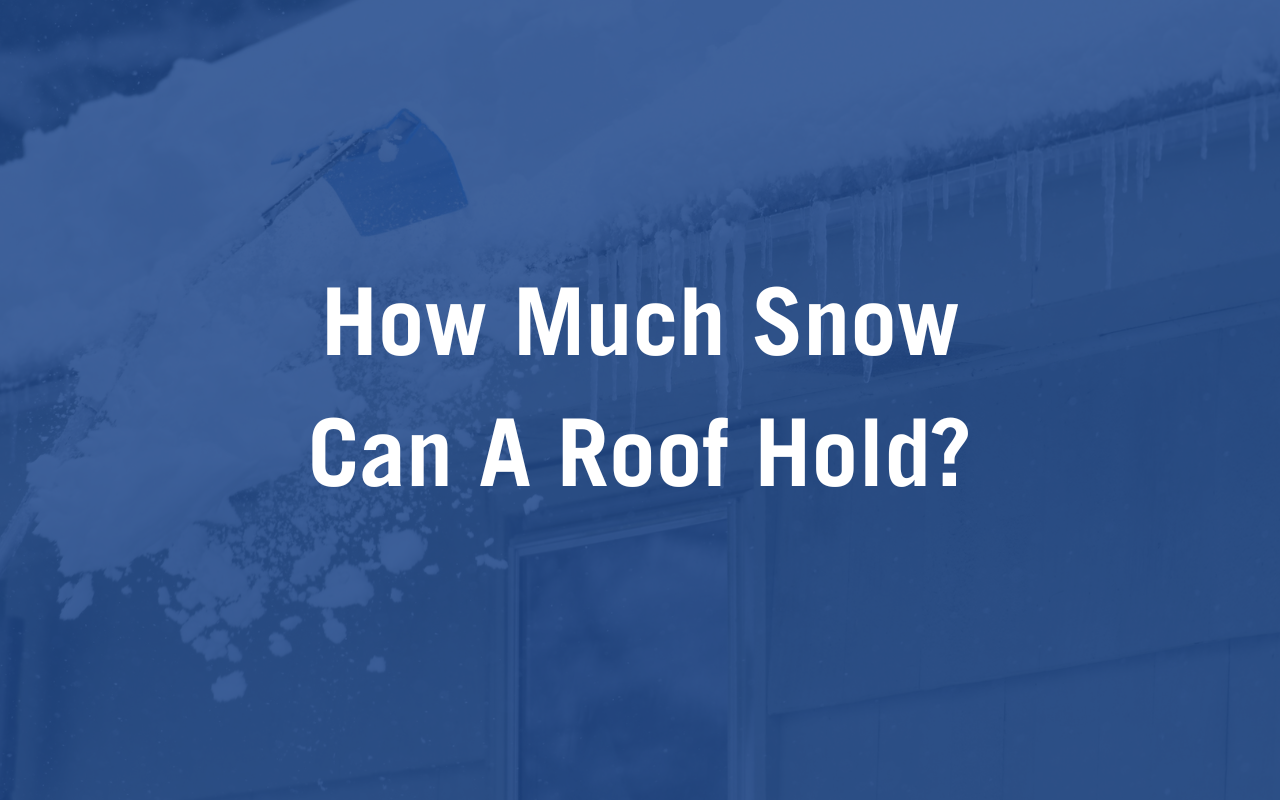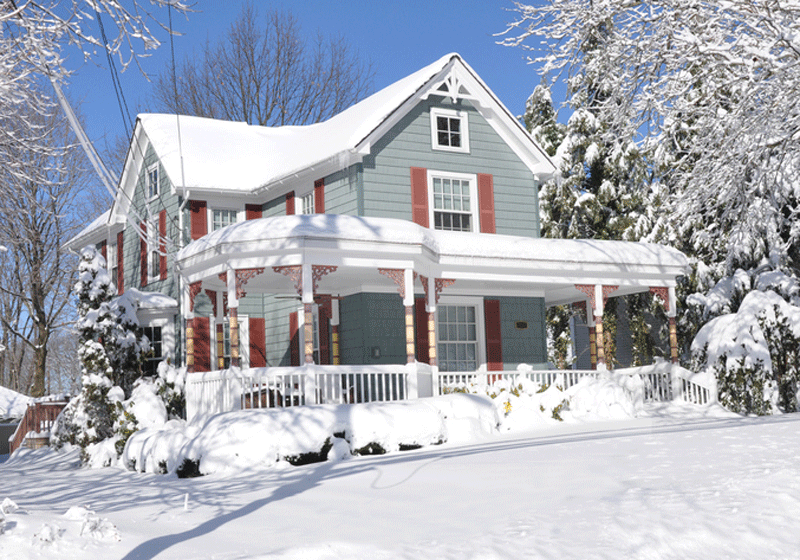Have you ever wondered how much snow a roof can hold? If heavy snowfall has you concerned about the safety of your roof, look no further. In this guide, we’ll break down snow load capacity and offer practical tips on protecting your roof and home.
Knowing how much snow a roof can safely handle, especially in areas prone to heavy snowfall, is critical to keeping your home protected. Heavy snow loads on the roof can lead to structural strain, leaks, and in the worst case, roof collapse. By understanding snow loads, homeowners can take action to avoid costly repairs and safety hazards.
Don’t risk damage to your home; let MEI’s experienced team help with all your roofing needs.
What Is Roof Snow Load?
Roof snow load is the amount of weight your roof can safely handle from accumulated snow and ice. The weight of the accumulated snow can cause leaks, sagging, or even collapse if it’s beyond the roofs structural limit. Understanding how much snow is too much for a roof is key to protecting your home throughout the harsh winter months and beyond.
Factors of Snow Load Capacity
So, how much weight can a roof hold? That depends on a variety of factors, including the roof slope for snow, shingle material, the age of the roof, and overall design. Each of the elements listed below impacts the roof’s ability to either naturally shed the snow or handle the weight of the snow over time.
- Roof Design and Pitch: The overall design and roof pitch for snow shedding both have an impact on snow load capacity. Steep roofs allow snow to shed naturally, reducing the risk of buildup, while low-pitched or flat roofs are more prone to snow and ice accumulation.
- Roof Materials and Age: Some roofing materials naturally handle the weight of snow better, like metal or composite. Older roofs become compromised over time, making them less capable of handling heavy snow on the roof.
- Building Codes and Regional Considerations: Local building codes will have snow load requirements that reflect the regional climate, including how much and how often you typically get snow as well as the type of snow. If your roof wasn’t built to local code, your home is at higher risk of damage from the snow load on the roof.
Types of Snow and Their Weights
Another key factor in roof snow load is that not all snow accumulation is the same. How much weight will a roof hold depends on snow types– dry, wet, or ice all have differing densities and weight. One foot of snow that is wet has more pounds per cubic foot than light, fluffy snow. This can quickly add significant weight and strain to your roof. Having awareness of these differences can help homeowners determine when to take action to prevent roof damage.
- Dry Snow (lighter and fluffy): 5 lbs per cubic foot
- Wet Snow (heavier and dense): 15-20 lbs per cubic foot
- Ice (heaviest and most dangerous): 57 lbs per cubic foot
Avoid the risk of trying to remove an ice dam on your own and hire Minnesota Exteriors for ice dam removal.
Warning Signs Your Roof May Be Overloaded
Excessive snow can put your roof in danger of stress and damage, especially over time and without proper intervention. Knowing the common warning signs of roof winter damage will help you know when intervention is required and mitigate further issues. If you notice any of the below issues, act quickly by clearing the snow or calling in a professional.
- Sagging rooflines or ceilings: A saggy roofline or ceiling inside is a clear indication of a roof overloaded with too much weight.
- Cracks in walls, drywall, or roof seams: Cracks at the roof seams or in interior walls can also signal structural roof strain or shifting due to an overloaded roof.
- Water leaks or stains on walls and ceilings: Any sign of water indoors is a red flag, signaling that melted snow is coming due to a compromised roof.
- Creaking, popping, or groaning sounds: Strange noises are another hint that your roof is under structural stress due to the weight of snow.
- Doors or windows becoming difficult to open: Excessive accumulated snow on a rooftop can cause warping and shifting of the home’s structure and lead to difficulty opening and closing windows and doors.
Calculating Snow Load on Your Roof
To answer “How much does snow weigh?,” there is a formula that can be used. Understanding this formula can help you decide when snow removal is necessary to avoid overloading your roof and causing structural damage.
To simplify the snow density part, we need to remember our three categories of snow: dry, wet, and ice. Dry snow is light and fluffy and weighs roughly 5 pounds per cubic foot, while wet, heavy snow weighs up to 20 pounds per cubic foot. Ice, on the other hand, weighs a whopping 57 pounds per cubic foot! This makes it clear why taking care of ice dams is so important.
Snow Roof Load per sq. foot = Snow Density x Snow Depth
For example, how much weight is 3 ft thick of snow that is light and dry? Take the 5 lbs per cubic foot snow density of dry snow and multiply that by the 3 ft snow depth on your roof to get an estimated snow load per square foot of 15 lbs per square foot.
5 pounds per cubic foot x 3 feet = 15 pounds per square foot
Is your home winter-proof? Follow our checklist to properly winterize your home to keep your family warm and safe.
Consequences of Ignoring Excessive Snow Loads
According to the University of Minnesota, the snow load for Minnesota residential roofs is between 35 and 42 pounds per square foot, depending on what part of the state you live in. If your house is covered with snow, use the formula shared earlier to determine whether your roof with snow is nearing the snow load threshold.
Snow loads approaching the 30 pounds per square foot mark require immediate intervention to avoid the following common signs of damage.
- Roof collapse or structural failure: Heavy snow on a roof can cause strain and sagging, leading to structural failure or even roof collapse.
- Formation of ice dams leading to leaks and water damage: Ice dams form when snow melts and refreezes at the edge of the roof, preventing water from draining properly and leading to potential leaks.
- Long-term weakening of the roof structure: Cracked or warped shingles are a sign that water is not draining properly due to excessive snow and ice dams, putting your roof at further risk of damage.
How to Prevent Too Much Snow On A Roof
Preventing too much snow on a roof starts with proper maintenance. Each fall, take some simple steps to winterize your home, like clearing the gutters of dead leaves and debris to prevent ice dams and keeping your attic well-insulated to minimize snowmelt and refreeze on the roof.
For long-term protection, get a professional roof inspection annually to monitor for signs of stress or damage that could worsen with snow accumulation. Investing in preventative steps now will help ensure your roof holds up to even the snowiest winters.
Safe Snow Removal Practices
Preparing your home for winter storms includes making sure you have the right tools to handle snow removal safely. Use a non-metal roof rake with a telescoping handle to allow you to clear snow from the ground, and always leave an inch of snow on the roof to avoid damaging the shingles. If the snow is too heavy or hard to reach, don’t attempt to climb onto the roof.
Winter conditions make roofs extra slippery and dangerous, so call in a roofing expert to get the job done safely. Practicing safe snow removal protects both you and your roof from unnecessary risk and damage.
- Use roof rakes with long handles from the ground.
- Avoid metal tools that can damage the roof surface.
- Don’t climb onto the roof yourself in unsafe conditions.
Ice dams are one cause of winter roof leaks. Read our blog to learn more about preventing and managing roof leaks during the winter.
What to Do in Case of Roof Overload
If you suspect your roof is overloaded with snow, take immediate steps to prevent serious damage. For heavy accumulation or if wet snow or ice is involved, we recommend contacting a roofing professional to assess the situation and safely remove excess snow. Ice dams are common with snow-overloaded roofs, and can be tricky to mitigate on your own without causing harm to your roof or gutters. Once the snow is clear, your roofing professional can inspect the roof for hidden damage to keep your roof and home protected.
- Safely evacuate the area if collapse seems imminent.
- Contact a roofing professional or structural engineer immediately for an assessment.
- Avoid DIY repairs that may worsen the situation.
Schedule Your Free Roof Inspection or Ice Dam Removal with Minnesota Exteriors
If you live in an area with heavy snowfall during the winter months, monitoring and managing the snow load on your roof is essential to keeping your home protected and avoiding costly repairs. Accumulated snow can strain your roof and lead to the formation of ice dams, sagging, leaks, and more.
At Minnesota Exteriors, we know the unique challenges of Minnesota winters. With decades of experience, we’re here to protect your roof through expert care and maintenance so it holds up for even the harshest weather conditions.
If you’ve noticed ice dams accumulating as a result of a significant amount of snow piling on your roof, don’t wait until it’s too late. Reach out today to schedule your free roof inspection from Minnesota Exteriors and let us help you remove ice dams safely and effectively to protect your home.




